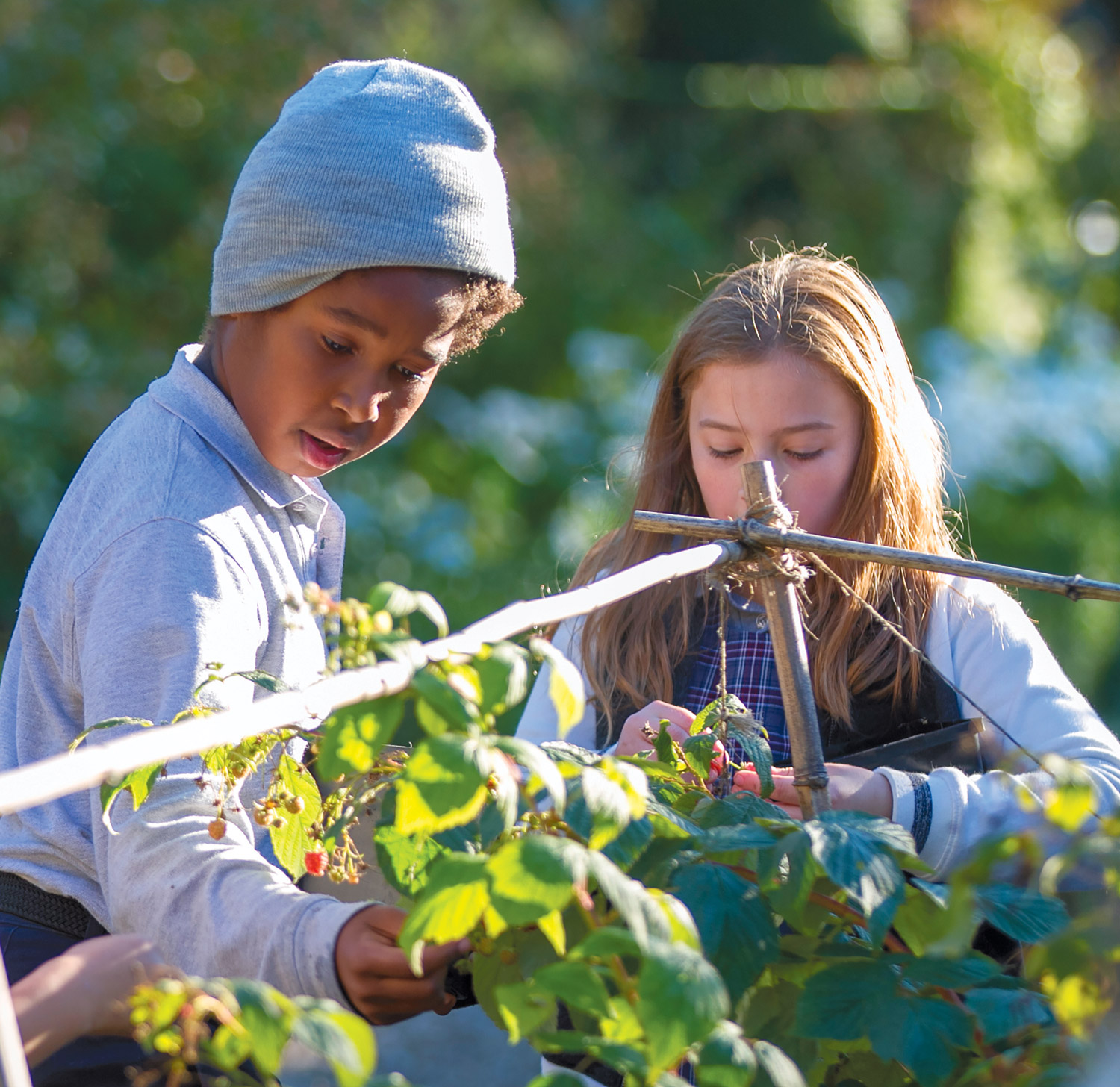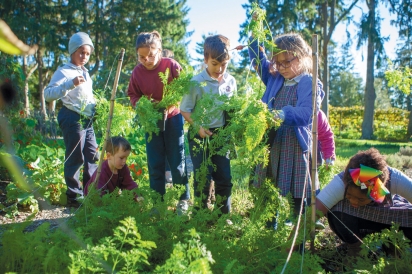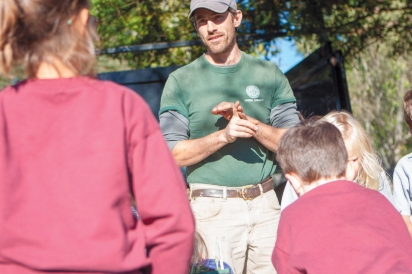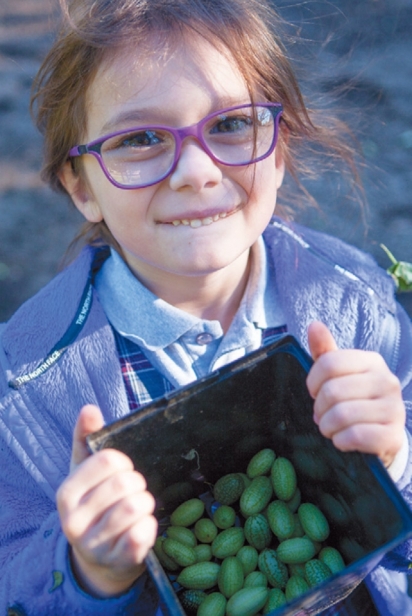The Edible Schoolyard at Green Animals in Portsmouth
Digging Dirt and Pulling Carrots: Growing a Healthy Appetite for Good Food and Gardening for Aquidneck Island’s Youth
Elementary education has come a long way since the centuries-old “three Rs”—reading, ’riting and ’rithmetic—formed the backbone of school curriculum. And while technology has advanced the spectrum of capability for today’s students, innovators like Alice Waters saw the antithesis of technology as fertile ground (quite literally) for expanding children’s minds—getting them back to the earth.
Waters, a world-renowned chef, author, food activist and founder of the original Edible Schoolyard Project (in 1995 in Berkeley, California), embraced “edible education” as an opportunity to teach children how to seed and grow a garden and to create and maintain a healthy relationship with food, and teach teachers to parlay agricultural methods into multiple facets of their curriculum.
Before Chief Horticulturist Dan Christina joined Green Animals Topiary Garden in Portsmouth, he worked in the grounds department at Blithewold Mansion, Gardens & Arboretum in Bristol, where he observed the success of a host of educational children’s programming. Green Animals, the oldest and most northern topiary garden in the U.S., dates back to 1872, when it was a small country estate with a pasture and vegetable garden.
Today, Green Animals is owned and operated by the Preservation Society of Newport County (PSNC), and is best known for its impressive collection of more than 80 topiary that are playfully manicured into teddy bears, birds, an elephant, giraffe, cat, rabbit, camel, ostrich and more, plus eye-catching geometric shapes sculpted from California privet, yew and English boxwood. With a comprehensive knowledge of the vegetable garden at Green Animals, Christina saw an opportunity to further inspire and ultimately educate the younger visitors.
The Edible Schoolyard at Green Animals officially launched in 2017 following a pilot program during the 2015–16 school year. Its first partnership was with neighboring St.
Philomena’s School, a parochial school whose students, pre-kindergarten through eighth grade, can walk from school to the gardens. Today, more than 400 students from both private and public schools across Aquidneck Island have participated in this innovative (and delicious) “edible curriculum.”
Initially funded with a grant from the Rhode Island Council for the Humanities, Edible Schoolyard has a mission to enrich academic subjects while teaching students sustainable gardening practices, proper nutrition and the role food gardens play in our social and cultural lives, says Abigail Stewart, the Preservation Society’s education and interpretive programs specialist. “Our initial planning was focused on linking humanities subjects like history and geography with a garden,” she explains. “We are hoping to expand by including both humanities and STEM integration in the program as it grows.”
While some school classes have visited for a one-time field trip, most participate over the course of the fall and/or spring months, staying for an hour and a half and connecting what is happening in their classroom to what is happening in the garden. “For example, if a kindergarten class is focusing on colors and shapes, one of our favorite lessons is ‘Eat Your Colors,’ which matches the nutritional benefits of the different colors you find in the garden to the colors in the rainbow,” says Stewart.
Christina and his staff will talk about the nutritional benefits associated with each color—such as how leafy green veggies keep bones and teeth strong—then students will pair a fruit or vegetable, like lime or broccoli, to its corresponding color.
“I love watching the kids eating something they might never try if offered in a different scenario,” says Christina. “They will literally eat kale right off the plants, try mustard greens, taste every variety of tomato and, always surprisingly, try the different herbs we grow, too. We have had the great fortune of having some repeat students, spring and fall, so they get to see their crops harvested year to year—they have seen the garden grow and evolve and have helped shape the way we use the space for education as well.”
Some students take a little more imagination to jump on board, admits Christina. For those who claim not to eat any veggies, he asks if they like pizza (which nearly all say they do); then Christina will talk about the variety of pizza toppings growing in the garden right at their feet.
Camille Guerin, a first-grade teacher at Forest Avenue Elementary School in Middletown, says the Edible Schoolyard program has offered her class myriad teachable moments.
“Many students think food comes from a grocery store and never had the experience with a garden, so it is an insightful experience for them to explore the gardens at Green Animals,” she says. “Children are thrilled and curious about where their food comes from, specifically root vegetables and digging those from the earth.”
PSNC provides schools with seedlings for students to plant in the classroom or their own school garden as well. “The students are able to see the complete growth cycle from seed to harvest,” says Guerin.
Fresh-pulled carrots, says Christina, seems to be the biggest hit with students amongst the nearly 100 varieties of fruits, vegetables, herbs and grains grown on site. “I have to plant carrots weekly in great abundance to keep up—once the kids have had a taste of a freshly dug carrot, they keep pulling!”
For hands-on activities, Christina and his team usually plant greens of all sorts, beans, radishes, turnips, carrots and potatoes and, every year, they try to showcase some of the less-common homegrown vegetables, including celery, beets and tomatillos. They experiment with tomatoes and peppers annually in search of the tastiest and most productive ones while creating fun trellises and structures for the beans, cucumbers and other vining crops.
“Additionally, we have grown wheat, quinoa, lovage, cotton—which was a favorite with everyone—lemongrass, celeriac and peanuts, too,” he says.
Throughout the weeks, the gardeners share their belief in organic gardening, pesticide-free growing and how adding flowering annuals or planting certain crops together can benefit the plants.
“I hope that all of the students and our visitors, too, leave the site with a better understanding of how to use vegetable garden spaces and the great and delicious variety of plants that are available to grow,” says Christina. All signs indicate they do, and the students are also learning another valuable life lesson: Growing food grows an opportunity to do good.
While students take home their plantings, much of the harvest from the Edible Schoolyard garden goes to the hunger services program at the Dr. Martin Luther King Community Center in Newport and Lucy’s Hearth, a shelter for homeless women and their children in Middletown, which Guerin calls, “a great ‘feel good’ learning experience for our students!”
For more information on the Edible Schoolyard program, visit the Edible Schoolyard and education page at NewportMansions.org. Information on seasonal visiting hours at Green Animals in Portsmouth can be found on the website as well.







